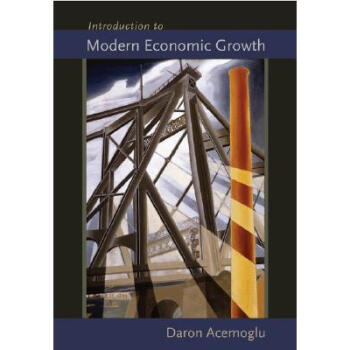-
提问 悬赏 求职 新闻 读书 功能一区
-
经济学人 二区
-
经济学论坛 三区
-
新商科论坛 四区(原工商管理论坛)
-
计量经济学与统计论坛 五区
-
数据科学与人工智能
-
金融投资论坛 六区
-
会计与财务管理论坛 七区
-
世界经济与国际贸易 八区
-
考研&考博&留学 九区
-
网络课堂 十区
-
站务区 十一区
-
休闲区 十二区
-
文库首页
- 热门文库
- 经管教学课件kindle电子书2万+全球顶级名校/投行英文文献 3000+世界顶级中英文杂志报刊【金融+经济+商学+国际政治】核心期刊投稿交流金融科技和互联网金融系列汇总【行业报告大全】BAFE文摘经管之家-Wiley文库【数学+统计+计算机编程】金融工程wwqqer系列汇总Shibor【历史+心理学+社会自然科学】2019经济报刊周刊精选经管之家-经典教科书出版社文库日新文库:Stata入门及进阶国内外经管期刊存档行为决策+行为经济学+行为金融经管之家-Springer文库Super CPA+CFA+ACCA+FRM Club学术杂志投稿经验微宽菜鸟吧产业研究院行业发展前景研究报告研报客-行业报告分享努力努力再努力Question & Answer(题库)金融万象Financial Vientiane学道会最美学习笔记Python ProgrammingFinancial Times 金融时报日新文库:高级经济学及经济数学上海财经大学课件、习题答案大全高清PDF【KYCHAN文库】外文杂志(sci ssci)投稿指南论文写作投稿实战IRT在家读MBA







 扫描二维码 下载应用
扫描二维码 下载应用



 京公网安备 11010802022788号
京公网安备 11010802022788号
您好,如需购买由经管之家论坛代理的普林斯顿出版社的原版精装书籍,欢迎添加客服微信咨询。请加客服微信:dzc123dzc
商品简介:
Introduction to Modern Economic Growth is a groundbreaking text from one of today's leading economists. Daron Acemoglu gives graduate students not only the tools to analyze growth and related macroeconomic problems, but also the broad perspective needed to apply those tools to the big-picture questions of growth and divergence. And he introduces the economic and mathematical foundations of modern growth theory and macroeconomics in a rigorous but easy to follow manner.
After covering the necessary background on dynamic general equilibrium and dynamic optimization, the book presents the basic workhorse models of growth and takes students to the frontier areas of growth theory, including models of human capital, endogenous technological change, technology transfer, international trade, economic development, and political economy. The book integrates these theories with data and shows how theoretical approaches can lead to better perspectives on the fundamental causes of economic growth and the wealth of nations.
Innovative and authoritative, this book is likely to shape how economic growth is taught and learned for years to come.
Introduces all the foundations for understanding economic growth and dynamic macroeconomic analysis
Focuses on the big-picture questions of economic growth
Provides mathematical foundations
Presents dynamic general equilibrium
Covers models such as basic Solow, neoclassical growth, and overlapping generations, as well as models of endogenous technology and international linkages
Addresses frontier research areas such as international linkages, international trade, political economy, and economic development and structural change
An accompanying Student Solutions Manual containing the answers to selected exercises will be available Spring 2009 (978-0-691-14163-3/$24.95). See: http://press.princeton.edu/titles/8970.html.
For Professors only: To access a complete solutions manual online, email us at: acemoglusolutions@press.princeton.edu
书评摘要:
Introduction to Modern Economic Growth is a groundbreaking text from one of today's leading economists. Daron Acemoglu gives graduate students not only the tools to analyze growth and related macroeconomic problems, but also the broad perspective needed to apply those tools to the big-picture questions of growth and divergence. And he introduces the economic and mathematical foundations of modern growth theory and macroeconomics in a rigorous but easy to follow manner.
After covering the necessary background on dynamic general equilibrium and dynamic optimization, the book presents the basic workhorse models of growth and takes students to the frontier areas of growth theory, including models of human capital, endogenous technological change, technology transfer, international trade, economic development, and political economy. The book integrates these theories with data and shows how theoretical approaches can lead to better perspectives on the fundamental causes of economic growth and the wealth of nations. Innovative and authoritative, this book is likely to shape how economic growth is taught and learned for years to come.
Introduces all the foundations for understanding economic growth and dynamic macroeconomic analysis
Focuses on the big-picture questions of economic growth
Provides mathematical foundations
Presents dynamic general equilibrium
Covers models such as basic Solow, neoclassical growth, and overlapping generations, as well as models of endogenous technology and international linkages
Addresses frontier research areas such as international linkages, international trade, political economy, and economic development and structural change
An accompanying Student Solutions Manual containing the answers to selected exercises is available (978-0-691-14163-3/$24.95). See: https: //press.princeton.edu/titles/8970.html.
For Professors only: To access a complete solutions manual online, email us at: acemoglusolutions@press.princeton.edu
内容简介:
该书是著名经济学家达龙·阿西莫格鲁的开创性著作,不仅为我们提供了分析增长和相关宏观经济问题的工具,而且给出了将这些工具应用于增长和国家之间发展差异等重大问题所需的广阔视角。
作者既介绍了现代经济增长理论的经济学和数学基础,又展示了经济增长理论的基础模型,还阐述了经济增长理论的前沿领域,包括人力资本、内生技术变革、技术转移、国际贸易、经济发展和政治经济因素等。作者将这些理论分析和数据相结合,说明了理论方法如何可以用来更好地理解经济增长和国富国穷的根本原因。
该书不仅系统全面,而且具有创新性和**性,将会影响未来经济增长领域的理论研究、教学方式乃至政策制定。
作者简介:
美】达龙·阿西莫格鲁,伦敦经济学院博士。1993年,入职麻省理工学院(MIT),,现为麻省理工学院“伊丽莎白和詹姆士·克利安”经济学讲席教授(The Elizabeth and James Killian Professor of Economics)。 2005年,被授予克拉克奖,该奖授予40岁以下对经济学做出杰出贡献的经济学家,素有“小诺贝 尔奖”之称。
阿西莫格鲁的主要研究领域包括政治经济学,发 展经济学,经济增长,技术、收入和工资的不平等,人力资源和培训,劳动经济学等。他也是畅销书《国家为什么会失败》的作者
前言/序言:
本书旨在解决两个问题。首要的一点,这是一本有关经济增长和长期经济发展的书。经济增长的过程和不同国家经济表现差异的来源是现代社会科学中最有趣、最重要且最具挑战性的领域。本书的首要目的就是引导研究生学习这些问题以及研究这些问题的理论工具。因此,本书致力于加强学生的动态经济分析背景,因为只有具备这种背景的学生才能更严谨地研究经济增长和经济发展问题。我还试图明确讨论世界经济现状背后的广泛经验模式和历史过程。这一叙述背后的动力源自我的信念,我坚信,为了理解为
什么一些国家实现了增长而其他国家没有,经济学家必须超越机械的模型,提出那些关于经济增长根本性原因的问题。
第二,本书也可以作为一本研究生层次的介绍现代宏观经济学和动态经济分析的教材。有观点认为,和基本的微观经济理论不同,当前并不存在被所有经济学家都认同的核心宏观经济理论。事实并不完全如此。尽管宏观经济学家在有关如何处理短期宏观现象和宏观经济学的边界应该是什么这些问题上存在分歧,但对于动态宏观分析的主力模型(workhorse model)还是存在着广泛的共识。这些模型包括索洛增长模型、新古典增长模型、叠代模型以及技术变化和技术应用模型。由于这些都是经济增长的模型,它们对现代经济增长的透彻分析也能够(也许是应该可以)对现代宏观经济提供关键材料。尽管有几本很好的研究生层次的宏观经济学教科书,但它们通常在基本的核心内容上花费的篇幅相对较少,而且没有介绍现代宏观经济分析与经济动态,以及与一般均衡理论之间的联系。相反,这本书虽然并没有涵盖宏观经济学的所有短期问题,但是它透彻而严谨地介绍了我心目中的宏观经济学的核心问题。
本书在谋篇布局上注意平衡两个目的。第1章、第3章和第4章介绍了经济增长过程的许多显著特点,以及经济表现跨国差异的来源。即使这几章没有更多介绍有关经济增长的实证研究,它们也为学生了解经济增长研究的关键问题提供了充足的背景知识,同时为学生进一步研究这些丰富的文献提供了平台。
第5章至第7章介绍了现代宏观经济分析的概念和数理基础。第5章对本书的很多其余部分(以及为大部分现代宏观经济学)给出了微观基础,而第6章和第7章简洁而又相对严谨地阐述了动态优化问题。大多数关于宏观经济学或经济增长的著作或者单独使用连续时间或者单独使用离散时间的概念。我认为要严谨地研究经济增长和现代宏观经济,就要求学生(以及研究人员)能够在使用离散时间和连续时间的表达式之间切换自如,为手中正在研究的一组问题选择更便利或者更合理的方法。因此,我在这里的方法和标准的处理方法不同,而是将连续时间和离散时间材料都贯穿全书。
第2章、第8章、第9章和第10章介绍了现代宏观经济学和传统经济增长问题的主力模型,而第11章介绍了可持续(内生)经济增长的第一代模型。第12章至第15章介绍了技术进步模型,这些模型是任何现代经济增长过程的必要组成部分。
第16章将第6章介绍的工具推广到随机环境中。使用这些工具,第17章介绍了随机增长的几个模型,最值得注意的是不确定性下的新古典增长模型,它是很多宏观经济学的基础(尽管它常常被排除在经济增长的课程之外)。标准的真实商业周期模型作为一个应用被引入。本章还介绍了另一个现代宏观经济学的主力模型,比利(Bewley)的不完全市场模型。最后,第17章还提出了一些其他方法,用以研究不完全市场和经济增长之间的相互作用,并且说明了随机增长模型如何有助于理解经济体从停滞或者缓慢增长状态转变为可持续增长的均衡状态。
第18章至第21章涵盖了有时被经济增长教科书遗漏的几个主题。这些主题包括技术应用模型、技术扩散模型、国际贸易和技术相互影响模型、结构变迁过程模型、人口转变模型、贫困陷阱可能性模型、不平衡的经济增长影响模型以及金融发展与经济发展相互影响模型。这些主题有助于我们在现实和理论中观察到的经验模式之间寻求联系。大多数传统增长模型考虑的是与世界隔离的单独经济体,而且通常是已经进入经济稳定增长阶段的经济体。研究有关国家间的相互依存、结构变迁以及经济起飞可能性的模型,将有助于我们把发展经济学的核心议题,例如结构变迁、贫困陷阱或者人口转变等和经济增长理论联系起来。
最后,第22章和第23章考虑的是常常被宏观经济学和经济发展教科书忽略的另一个主题:政治经济学。把这些内容纳入本书是受我的一个信念驱使,如果我们不思考引起各国间经济表现差异的根本原因并提出问题,就会严重阻碍我们对经济增长的研究。这些问题无情地将我们带到了经济政策和制度的跨国差异的面前。政治经济学帮助我们构建模型,搞清楚为何各国具有不同的经济政策和制度,而且它必将成为经济增长研究不可分割的一部分。
对本书的理念以及编排情况稍做介绍或许对学生和老师有所裨益。本书的基本理念是书中陈述的所有结论都应该得到证明或至少得到详细解释。这意味着本书和其他书籍多少有一些不同的编排方式。大多数经济学教科书并不会对很多被表述或者援引的结论给出证明过程,而且通常假定读者已经掌握了分析所需的数学工具或者将这些工具放在附录。相反,我对本书表述的几乎所有结论都尽可能地进行简单证明。结果表明,一旦去除不必要的一般性,大部分结论都可以用一种研究生比较容易理解的方式来表述和证明。实际上,我相信即使是长一点的证明也比缺乏证明的一般陈述更容易理解,因为读者往往会对这些陈述的真实性感到怀疑。